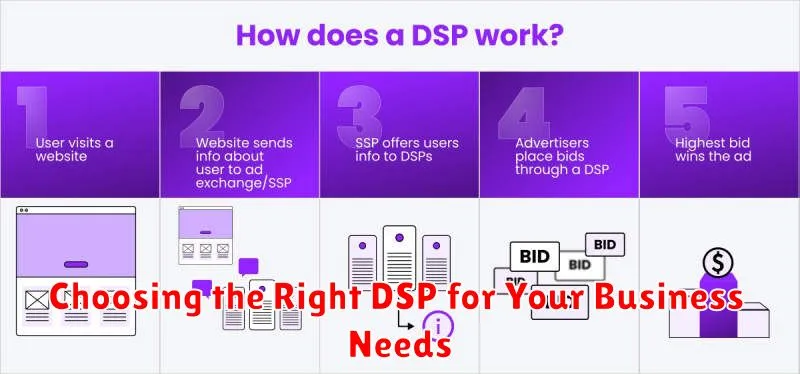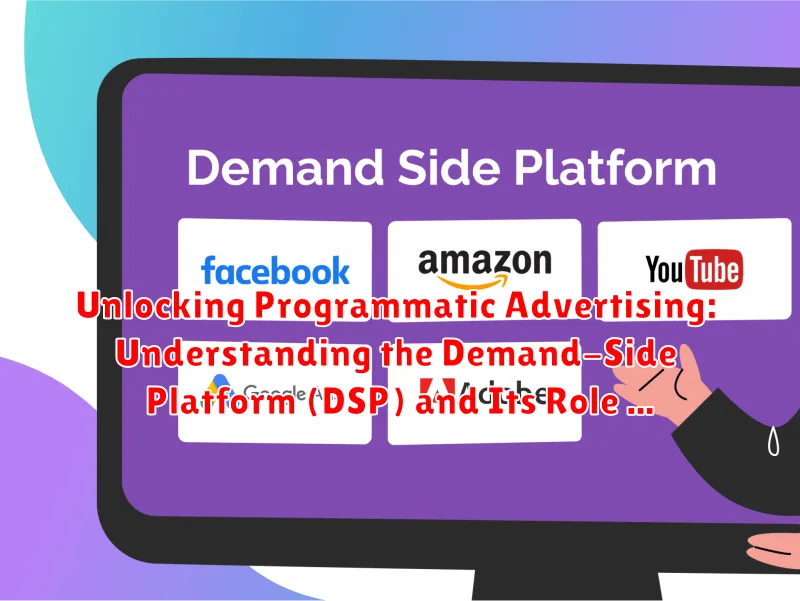In today’s dynamic digital marketing landscape, achieving optimal advertising reach and efficiency is paramount. Programmatic advertising has emerged as a critical strategy for businesses aiming to connect with their target audiences in a data-driven and automated manner. At the heart of this transformative approach lies the Demand-Side Platform (DSP), a sophisticated technology empowering advertisers to strategically buy and manage ad inventory across various channels. Understanding the functionalities and capabilities of a DSP is crucial for marketers seeking to maximize their Return on Investment (ROI) and gain a competitive edge.
This article aims to demystify the Demand-Side Platform (DSP) and explore its integral role in modern marketing. We will delve into the core components of a DSP, including its real-time bidding (RTB) capabilities, audience targeting options, and reporting functionalities. By examining how a DSP integrates with the broader programmatic advertising ecosystem, advertisers will gain valuable insights into leveraging this powerful tool to optimize their campaigns, reach the right consumers at the right time, and ultimately, drive meaningful business outcomes through data-driven advertising strategies. We will discuss how DSPs work with Supply-Side Platforms (SSPs) and ad exchanges to create a seamless process for buying and selling digital ad space.
What is a Demand-Side Platform (DSP) in Advertising?
In the realm of programmatic advertising, a Demand-Side Platform (DSP) is a sophisticated technology platform that allows advertisers to automatically buy and manage digital advertising inventory from multiple sources. Think of it as a centralized hub for purchasing ad space across various publishers and ad exchanges.
Unlike traditional advertising methods, a DSP utilizes real-time bidding (RTB) to evaluate and bid on ad impressions as they become available. This process occurs within milliseconds, ensuring that advertisers can reach their target audience with the right message at the right time.
Key aspects of a DSP include:
- Centralized Ad Buying: Consolidates access to numerous ad exchanges and supply-side platforms (SSPs).
- Real-Time Bidding (RTB): Enables automated bidding on individual ad impressions.
- Targeting Capabilities: Offers advanced targeting options based on demographics, interests, behavior, and more.
- Data-Driven Optimization: Leverages data to optimize campaign performance and improve ROI.
Key Features and Functionality of a DSP
A Demand-Side Platform (DSP) offers a suite of powerful features designed to streamline and optimize digital advertising campaigns. Central to its functionality is real-time bidding (RTB), enabling advertisers to participate in automated auctions for ad impressions across numerous publishers.
Key features include:
- Inventory Aggregation: Access to a vast pool of ad inventory from multiple ad exchanges and supply-side platforms (SSPs).
- Targeting Options: Granular targeting capabilities based on demographics, interests, behavior, and context.
- Real-Time Bidding (RTB): Automated bidding based on pre-defined strategies and real-time data signals.
- Reporting and Analytics: Comprehensive data insights into campaign performance, allowing for continuous optimization.
- Optimization Algorithms: Automated optimization tools that adjust bids and targeting parameters to maximize ROI.
Furthermore, DSPs often incorporate features like creative management, allowing users to upload and manage various ad formats, and brand safety controls to ensure ads are displayed in appropriate contexts.
How Does a DSP Work in the Programmatic Ecosystem?
A Demand-Side Platform (DSP) functions as the central hub for buyers to purchase advertising programmatically within the digital advertising ecosystem. Its core function is to automate and optimize the ad buying process across multiple ad exchanges and supply-side platforms (SSPs).
Here’s a breakdown of the process:
- Advertiser Setup: Advertisers define their campaign goals, target audience, budget, and creative assets within the DSP.
- Real-Time Bidding (RTB): When a user visits a website or app, the publisher sends a bid request to ad exchanges, including user data and information about the ad placement.
- DSP Analysis: The DSP analyzes the bid request, matching it against the advertiser’s targeting criteria.
- Automated Bidding: If the impression aligns with the campaign parameters, the DSP automatically bids on it in real-time.
- Winning Bid and Ad Delivery: The ad exchange determines the winning bid, and the advertiser’s ad is served to the user via the DSP.
- Performance Tracking and Optimization: The DSP continuously tracks campaign performance and adjusts bidding strategies to optimize for key metrics such as clicks, conversions, and return on ad spend (ROAS).
Benefits of Using a DSP for Digital Advertising Campaigns
Utilizing a Demand-Side Platform (DSP) offers numerous advantages for digital advertising campaigns. A primary benefit is enhanced targeting capabilities, allowing advertisers to reach specific audiences based on demographics, interests, and behaviors. This precision minimizes wasted ad spend and maximizes the impact of advertising efforts.
Another key advantage is real-time optimization. DSPs enable advertisers to monitor campaign performance and make immediate adjustments to bids, creatives, and targeting parameters, ensuring optimal results throughout the campaign lifecycle. This agility is crucial in a dynamic digital landscape.
Furthermore, DSPs provide access to a wide range of ad inventory across various publishers and ad exchanges. This comprehensive reach allows advertisers to scale their campaigns and connect with potential customers across diverse online environments.
Finally, improved reporting and analytics offer greater transparency into campaign performance. Advertisers can gain valuable insights into which strategies are most effective, enabling data-driven decision-making and continuous improvement of future campaigns.
DSP vs. Ad Network: Understanding the Key Differences
While both Demand-Side Platforms (DSPs) and Ad Networks play a role in digital advertising, they operate differently and offer distinct advantages.
An Ad Network acts as an intermediary, aggregating ad inventory from various publishers and selling it to advertisers. They typically offer packages of inventory based on categories or demographics. The advertiser has less control over where their ads appear.
A DSP, on the other hand, provides a centralized platform for advertisers to buy ad space across multiple ad exchanges and networks. It allows for real-time bidding (RTB), giving advertisers precise control over targeting, bidding strategies, and ad placement. DSPs leverage sophisticated algorithms and data to optimize campaign performance.
Here’s a simplified comparison:
- Control: DSPs offer granular control; Ad Networks offer less control.
- Inventory Source: DSPs access multiple sources; Ad Networks aggregate from specific publishers.
- Optimization: DSPs utilize advanced data-driven optimization; Ad Networks offer more limited optimization.
- Transparency: DSPs provide greater transparency into ad placement; Ad Networks offer less transparency.
In essence, Ad Networks offer a simpler, less flexible option, while DSPs empower advertisers with sophisticated tools for precise targeting and optimization.
Choosing the Right DSP for Your Business Needs

Selecting the appropriate Demand-Side Platform (DSP) is a crucial decision that significantly impacts the success of your programmatic advertising campaigns. The ideal DSP aligns with your specific business objectives, target audience, and available resources. Consider these key factors when making your choice:
- Business Goals: Define your campaign goals clearly (e.g., brand awareness, lead generation, conversions). Some DSPs specialize in certain areas.
- Target Audience: Identify your ideal customer profile. Look for DSPs with robust targeting capabilities, including demographic, behavioral, and contextual targeting options.
- Budget and Pricing Models: DSPs offer various pricing models (e.g., CPM, CPC, CPA). Choose a model that aligns with your budget and campaign goals. Ensure transparency in pricing.
- Data Integration and Analytics: A DSP should seamlessly integrate with your existing data sources (e.g., CRM, website analytics). Comprehensive reporting and analytics are essential for campaign optimization.
- Support and Training: Assess the level of support and training provided by the DSP vendor. Responsive customer support and comprehensive training resources are valuable assets.
The Role of Data in Optimizing DSP Campaigns
In the realm of programmatic advertising, data serves as the cornerstone for optimizing Demand-Side Platform (DSP) campaigns. By leveraging data-driven insights, marketers can enhance targeting precision, refine bidding strategies, and ultimately, improve campaign performance.
First-party data, such as website visitor behavior and customer purchase history, provides valuable insights into audience characteristics and preferences. Third-party data, aggregated from various sources, expands the reach and depth of audience understanding. Contextual data ensures that ads are displayed in relevant environments, increasing engagement and brand affinity.
DSPs utilize machine learning algorithms to analyze vast datasets in real-time, identifying patterns and trends that inform campaign optimization. These algorithms continuously adjust bids, ad placements, and targeting parameters based on performance data, ensuring that campaigns are always evolving and improving. Through rigorous A/B testing, advertisers can compare different ad creatives, landing pages, and targeting approaches to identify the most effective combinations.
Future Trends in DSP Technology and Programmatic Advertising

The landscape of Demand-Side Platforms (DSPs) and programmatic advertising is in constant evolution. Several key trends are poised to reshape the future of this dynamic sector.
Artificial Intelligence (AI) and Machine Learning (ML) will play an increasingly significant role. Expect to see more sophisticated algorithms that enable more granular targeting, optimized bidding strategies, and predictive analytics for campaign performance. This includes advancements in creative optimization, leveraging AI to dynamically adjust ad creatives based on user behavior.
Enhanced Transparency and Brand Safety are becoming paramount. The industry is moving toward greater clarity in the ad supply chain and implementing robust measures to combat ad fraud and ensure brand-safe environments. Blockchain technology might also play a role in verifying ad transactions.
Expansion of Channels and Formats: DSPs will likely support a wider range of advertising channels, including Connected TV (CTV), Digital Out-of-Home (DOOH), and audio advertising. This expansion necessitates advanced features for cross-channel campaign management and attribution.
Focus on Privacy-Centric Advertising: With increasing concerns around data privacy, DSPs are adapting to new regulations and developing solutions that prioritize user privacy while still enabling effective targeting. This includes exploring anonymized data and contextual advertising strategies.
Common Challenges and Considerations When Implementing a DSP
Implementing a Demand-Side Platform (DSP) can significantly enhance digital advertising campaigns, but it also presents several challenges and requires careful consideration.
Data Quality and Integration
Ensuring data quality is paramount. Inaccurate or incomplete data can lead to ineffective targeting and wasted ad spend. Integrating the DSP with existing data sources, such as Customer Relationship Management (CRM) systems, can be complex and require significant technical expertise.
Transparency and Brand Safety
Maintaining transparency in the programmatic ecosystem is crucial. Advertisers need clear visibility into where their ads are being placed to ensure brand safety. Fraudulent ad impressions and placement on inappropriate websites are ongoing concerns that require constant monitoring and mitigation.
Cost Management and Optimization
Effectively managing costs and optimizing campaigns requires continuous monitoring and adjustments. Advertisers must understand the various bidding strategies and algorithms offered by the DSP and implement them strategically to achieve their desired return on investment (ROI). A deep understanding of programmatic advertising principles is essential for successful implementation.

